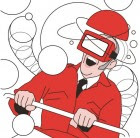 A surprise gift for father's day was a Fitbit ChargeHR. The HR stands for Heart Rate, that measures beats per minute (BPM). It doesn't measure blood pressure, and I don't think any device like this on the wrist will be able to do that soon. I have been counting my walking distances, steps up stairs, calories and sleep activity for about a week now. It feels good to have entered the world of the "quantified self "and big data personal health informatics at more than just a theoretical level, as I have been doing on this blog for the past 4 years. I actually have a blog post about Fitbit from 3 years ago <here>!
A surprise gift for father's day was a Fitbit ChargeHR. The HR stands for Heart Rate, that measures beats per minute (BPM). It doesn't measure blood pressure, and I don't think any device like this on the wrist will be able to do that soon. I have been counting my walking distances, steps up stairs, calories and sleep activity for about a week now. It feels good to have entered the world of the "quantified self "and big data personal health informatics at more than just a theoretical level, as I have been doing on this blog for the past 4 years. I actually have a blog post about Fitbit from 3 years ago <here>!The data is sent wirelessly to a small "dongle" on my MacBook anytime I am within 20 feet of it. I was surprised to see how this data easily integrated with Telus (Microsoft) Health Space (Healthvault) from the Fitbit.com login settings account. The power of the API is truly awesome.
As I knew before when I was looking at reviews for smart watches, the Fitbit ChargeHR is not a great watch for telling the time. However, one advantage is I find myself saving a lot of time by not looking at my watch to find out what time it is so often. All in all, I find myself wanting to wear it more than the old watch.
Sleeping with the watch is perfectly unobtrusive. There are continual double green sensor lights flashing for the BPM readings but it is hidden under the wrist. At a different viewing angle you can see the green lights. Double tapping at night will illuminate the clock (and day of the month) but during the day it is very difficult to see the digital time in glare of light of day. When you wake in the morning, sleep activity data is automatically transmitted to the MacBook or the Fitbit app on the iPad. via the dongle. The sleep data is a bit hard to interpret. Did I really only get 5 hours sleep? Anyway, I am starting to make some sense of the times I may have been awake or restless.
If you set a goal for 10,000 steps it will buzz on your wrist when you achieve the goal. You are also sent an email congratulating you, which is repeated in the weekly email data digest updates. I tracked food consumption for data on calories, sodium levels, etc. for a few days, and this is very interesting information for me. Since I have not really changed weight since I was a teenager, I don't really have any weight goals, but I know I can align readings from the gym equipment which tracks BPM and calories burned with the Fitbit. When I am not going to the gym, I can utilize those readings. But like I said, watching calories burned is not a science I follow much because of my metabolism.
Even though the data is integrated into the Telus HealthSpace, which is a free personal health record if you have a Microsoft login, I still don't find myself using the personal health record that much (yet). I also have a McMaster PHR (former MyOSCAR) and a Health and Wellness Companion PHR through my employer's health insurance company, in both of which I have just stepped into the shallow end of the pool. I tend to keep a Word document log and paper file of health related events a lot more. If the PHR was integrated with our family health team, I am sure I would use it more.
So, I think we are still a way off from wider adoption of personal health records as integrated tools for the physician's electronic medical record. A lot depends on more research, and of course evolving software breakthroughs like APIs. I am a community volunteer with the McMaster University Family Medicine TAPESTRY program, and I can see first hand the uptake on PHRs and how much education and training is required before they are being used effectively. On our visits to seniors in our communities we also help promote the use of the McMaster PHR. Like any technology, and the toothbrush comes to mind, use comes from developing good habits, as well as promotion from health care professionals.
Because we have entered a digital culture, many people will be entering a personal health record, not through their family medicine clinic, but through some form of personalized health informatics, like Fitbit data, or smart phone apps. There will be a point when physician medical practices will want to buy into accessing or making that data available.


 http://www.ncbi.nlm.nih.gov/pmc/articles/PMC3392857/
http://www.ncbi.nlm.nih.gov/pmc/articles/PMC3392857/ 1 and
1 and 


















